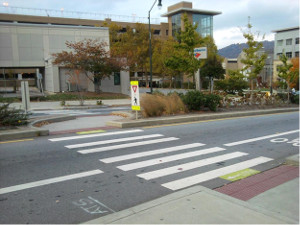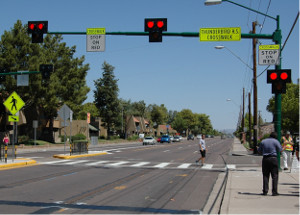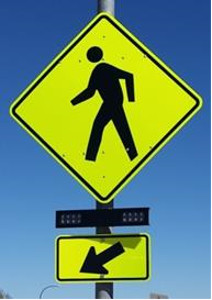EDC Spotlight on Safe Transportation for Every Pedestrian (STEP)
(Source: FHWA)
The Federal Highway Administration (FHWA) is featuring a collection of five cost-effective pedestrian safety countermeasures in its Every Day Counts (EDC) initiative. Expanded use of these countermeasures, collectively known as "Safe Transportation for Every Pedestrian" (STEP), is expected to reduce pedestrian injuries and fatalities. Twenty-five states (including Tennessee) and the Virgin Islands plan to demonstrate and assess STEP countermeasures. Another 17 states and Washington, DC, expect to institutionalize STEP countermeasures by the end of EDC-4.
State and National Pedestrian Safety Statistics
Nationally, pedestrians account for over 17.5 percent of all fatalities in motor vehicle traffic crashes. In Tennessee, pedestrians have risen from 68 of 1,014 traffic deaths (6.7 percent) in 2012, to 101 of 1,041 traffic deaths (9.7 percent) in 2016. As of May 26, pedestrian deaths account for 45 of 380 traffic fatalities (11.8 percent) so far in 2017.
The majority of these pedestrian traffic deaths occur at uncontrolled crossing locations such as midblock or un-signalized intersections. According to the National Highway Traffic Safety Administration (NHTSA), only 18% of calendar year 2015 pedestrian traffic fatalities occurred at intersections. These are among the most common locations for pedestrian fatalities generally because of inadequate pedestrian crossing facilities and insufficient or inconvenient crossing opportunities, all of which create barriers to safe convenient, and complete pedestrian networks.

Expecting pedestrians to travel significantly out of their way to cross a roadway to reach their destination is unrealistic and counterproductive to encouraging healthier transportation options. By focusing on uncontrolled locations, agencies can address a significant national safety problem and improve quality of life for pedestrians of all ages and abilities.
STEP Pedestrian Safety Countermeasures
FHWA is promoting the following pedestrian safety countermeasures through the fourth round of Every Day Counts (EDC-4):
- Road Diets can reduce vehicle speeds and the number of lanes pedestrians cross, and they can create space to add new pedestrian facilities.
- Pedestrian hybrid beacons (PHBs) are a beneficial intermediate option between RRFBs and a full pedestrian signal. They provide positive stop control in areas without the high pedestrian traffic volumes that typically warrant signal installation.
- Pedestrian refuge islands allow pedestrians a safe place to stop at the midpoint of the roadway before crossing the remaining distance. This is particularly helpful for older pedestrians or others with limited mobility.
- Raised crosswalks can reduce vehicle speeds.
- Crosswalk visibility enhancements, such as crosswalk lighting and enhanced signing and marking, help drivers detect pedestrians — particularly at night.

Benefits of STEP Countermeasures
- Improved Safety. Countermeasures are available that offer proven solutions for reducing pedestrian fatalities at uncontrolled crossing locations.
- Targeted Investment. By focusing on uncontrolled locations, agencies can address a significant national pedestrian safety problem.
- Enhanced Quality of Life. Improving crossing opportunities boosts quality of life for pedestrians of all ages and abilities.

State of the Practice
Road Diets, pedestrian refuge islands, and PHBs are all considered Proven Safety Countermeasures by FHWA. FHWA is also promoting Road Diets through EDC-3.
The Tennessee Department of Transportation (TDOT) is developing a program that identifies high crash pedestrian corridors and intersections. Road safety audits will be conducted at these locations and countermeasures will be implemented.
Other communities benefitting from the use of STEP countermeasures include Austin, Texas, where at least 39 PHBs are already installed and residents can request additional sites for them. In Michigan, the Department of Transportation (DOT) developed a Road Diets checklist to ensure smooth administrative procedures.
Countermeasures such as rectangular rapid flashing beacons (RRFBs), crosswalk lighting, and raised crosswalks are being promoted through FHWA's PEDSAFE, a tool that helps ransportation agencies diagnose and treat pedestrian safety issues. PEDSAFE includes numerous case studies that describe how communities across the country have implemented these safety improvements. The RRFB has been demonstrated to greatly increase driver yielding rates in several communities, including St. Petersburg, Florida.
This EDC-4 effort will help more communities deploy these pedestrian safety improvements based on their specific roadway contexts and needs. It also aligns with U.S. DOT's Safer People, Safer Streets initiative and with other U.S. DOT efforts such as Ladders of Opportunity, which aims to provide people with safe, reliable and affordable connections to employment, education, healthcare and other essential services.
STEP is also an important action in FHWA's Strategic Agenda for Pedestrian and Bicycle Transportation, which is a collaborative framework for pedestrian and bicycle planning, design, and research efforts being developed over the next five years.
To learn more about the pedestrian safety innovations described in this
article, please visit the FHWA website at (https://www.fhwa.dot.gov/innovation/everydaycounts/edc_4/step.cfm).
Back-Contents-Forward